![]() The latest Accretionary Wedge, being hosted at Geology Happens, asks: what are you working on? This seemed to me to be a good excuse to finally write something about this whole Snowball Earth thing that I’m currently researching. More musings will hopefully follow in the future.
The latest Accretionary Wedge, being hosted at Geology Happens, asks: what are you working on? This seemed to me to be a good excuse to finally write something about this whole Snowball Earth thing that I’m currently researching. More musings will hopefully follow in the future.
Why did visit I Oman last year? Because in Oman you can find Late Neoproterozoic rocks, between about 750 and 600 million years in age, that contain sequences like this:


There are two very different rock units in this outcrop. The lower part consists of a diamicite: a sedimentary rock that contains both very fine particles (the dark grey matrix) and also large pebbles, cobbles and even occasionally boulders, and possibly everything in between (this range of different grain sizes means that is a poorly sorted sediment).

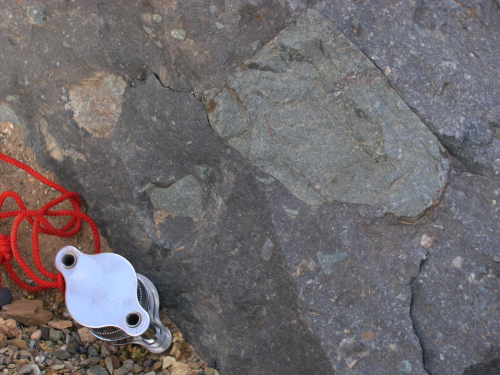
The buff coloured unit deposited directly above this is a carbonate rock, more specifically dolomite; it is crystalline, and generally quite fine grained.

This is not just an outcrop of extremes because of the obvious lithological differences between the two units. Diamictites are often interpreted as having being deposited in a glacial environment*. Bedrock underneath a glacier is very efficiently ground up into fine powder by the slowly moving ice, while larger rock fragments are also swept along, frozen within the main body of the glacier itself. Thus, when the ice melts at the end of a glacier, fine and coarse material will all get mixed up in the same deposit. However, whilst this suggests that the lowermost unit was deposited in a very cold, icy climate, the carbonate appears to have been directly chemically precipitated from seawater, something which only happens in warm, tropical conditions – think the Bahamas. There is no sign of a large time gap between the formation of these two units, so if these interpretations are correct, this outcrop records an extremely abrupt climatic shift from very cold conditions to very warm ones.
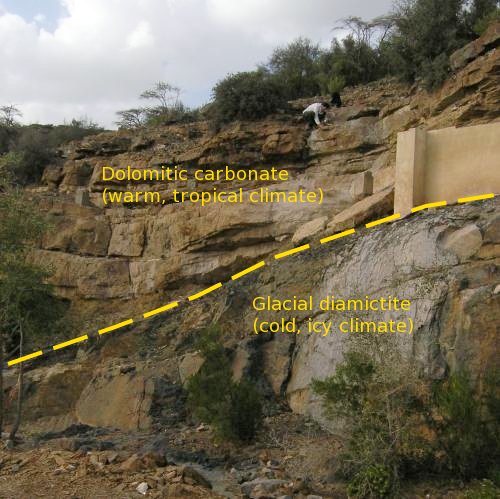
This is not a one-off occurrence. A composite stratigraphic section of the Neoproterozoic of Oman shows that there are actually two diamictite/carbonate couplets, and older one about 700 million years old, and a younger one about 630 million years old (the younger one is the one pictured above).
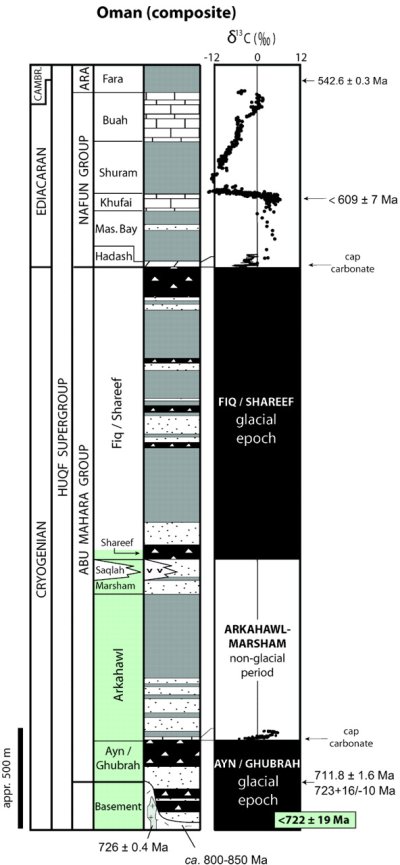
Composite stratigraphy for the Neoproterozoic of Oman.
And if that wasn’t interesting enough, there’s also the question of where on the planet Oman was when this sequence was deposited. Limited palaeomagnetic studies indicate that the diamictites and the carbonates carry an ancient magnetization with a very shallow, almost horizontal dip, which you would only find if the rock carrying that magnetization formed close to the equator (magnetic field lines are horizontal at the equator, and vertical at the poles).
So, 700 million years ago, the bit of continental crust that would eventually become Oman was close to the equator. Yet despite this, it was covered in glaciers. Then, suddenly, it wasn’t. Instead, much more in keeping with its tropical latitude, it was covered by a shallow, warm lagoonal sea. 70 million years later, the same thing happened again: Oman was apparently still at a low latitude, yet the glaciers encroached once more, until they once more abruptly vanished.
Diamictites of around the same ages, and interpreted to have similarly glacial origins, are found on every continent on Earth, and many of them are also capped by warm-water carbonates. Palaeomagnetic evidence suggests at least some of them formed at very low latitudes. Thus the global picture appears similar to that seen in Oman: extreme glaciations, with ice caps extending to far lower latitudes than even during the last Ice Age 20,000 years ago, followed by an extremely abrupt deglaciation and the deposition of limestone where once there was ice.
So how do we explain this extreme climatic picture? Perhaps the most provocative hypothesis is the ‘Snowball Earth‘, which posits that the widespread glacial sequences record times when the entire Earth froze over. This is actually not so far-fetched if extensive ice sheets did indeed reach equatorial regions. If you cover a continent or ocean with highly reflective ice, solar radiation that would otherwise be absorbed is instead reflected back into space, reducing the surface temperature. Reducing the temperature leads to the growth of more reflective ice, which leads to further falls in temperature, which leads to more growth…** This negative ice-albedo feedback effectively means that once ice sheets extend to within about 30 degrees of the equator, they will quickly, and irreversibly, continue to grow until the entire globe is frozen over.
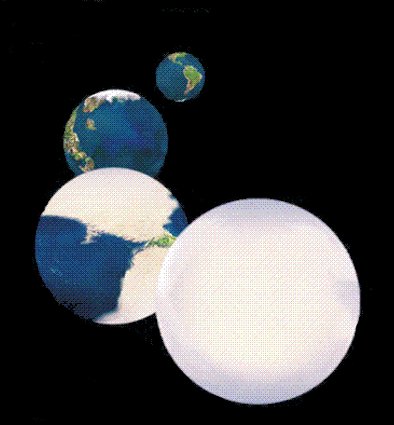
The real problem is what happens then. The high planetary albedo will keep temperatures extremely low, so how do you melt all that ice? According to the Snowball Earth hypothesis, plate tectonics comes to the rescue. A surface scum of ice does not stop rifting or subduction, so there will still be active volcanoes producing carbon dioxide. Because a global freeze would effectively halt both continental weathering and photosynthesis, which are the main ways that carbon dioxide is taken out of the atmosphere, so the concentration of this greenhouse gas would steadily increase over geological time. Eventually, the atmosphere would trap enough heat to counteract the cooling effect of ice albedo, and the Snowball Earth would start to melt. At this stage, CO2 would perhaps make up about 12% of the atmosphere, more than 300 times its current concentration. Once the ice had melted, the full effect of this would be felt, leading to a fearsome ‘supergreenhouse’ which more than explains the apparent transition to warm water conditions recorded by the cap carbonates.
To call this hypothesis ‘provocative’ would be an understatement. But is it true? The sequences in Oman also illuminate several of the problems which may yet undermine the whole grand and sweeping story. The first problem is the assumed correlation between all of the different glacial deposits. Working out the relative ages of more modern sediments relies heavily on the use of index fossils, but prior to the appearance of mineralised body parts at the dawn of the Cambrian, the fossil record is so patchy as to make this impossible. Unless there are any conveniently datable volcanic horizons, this means that there are often large error bars on our age estimates. In Oman, the main glacial unit in southern Oman was correlated with the youngest of the two glacial formations in the north, so was thought to be around 630 million years old – until the almost eroded remnants of a younger glacial formation were found above it. With two glacial formations in both the southern and northern Oman, the proposed correlation has changed, with the newly discovered unit being 630 million years old, and the more prominent diamictite below it being 700 million years old. Making it 70 million years older is actually well within the chronological error bars, and herein lies the problem: if the current dating uncertainties are such that geologists can encounter problems correlating Neoproterozoic sequences on the same block of crust, it is even more difficult to confidently correlate those sequences to others on entirely different continents.
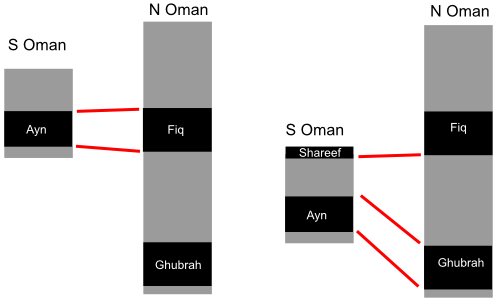
The Ayn diamictite unit in South Oman was originally correlated with younger Fiq formation in the north, but the discovery of the younger Shareef formation in the south led to this correlation being revised.
The palaeomagnetic data pointing to low latitude glaciations are also not quite as clear cut as we would like. As rocks get older, the chances of them getting remagnetised by later igneous or tectonic activity increases. There are ways of testing whether the magnetisation you are measuring actually formed at the same time as the rock did; in the case of Oman the results of these tests were a little inconclusive.
The group that I’m currently part of is attempting to address some of these uncertainties, in Oman and elsewhere. More dating studies can narrow the error bars and improve correlations. More comprehensive paleomagnetic sampling can prove or disprove the presence of remagnetisations. And, on a broader scale, we’re interested in the reason why the Late Neoproterozoic seemed to have been a time of such extreme climatic shifts (which definitely seems to have been the case, even if you don’t buy the ‘hard’ Snowball Earth where the oceans completely froze over). Over geological timescales, one of the fundamental controls on the Earth’s climate is tectonics: the position of the continents and mountain belts determines the route oceanic and atmospheric currents which move heat between the poles and the equator. The Snowball Earth period appears to coincide with the break-up of the supercontinent Rodinia, but quite how all the different crustal fragments were arranged within this older version of Pangaea, and the timing and sequence of its dismemberment, are still quite poorly understood. By looking at the whole of the Neoproterozoic record, and not just the glacial deposits themselves, our project is aiming to try and work out was was going on tectonically and see what geological changes might have influenced the climatic deterioration that resulted in the severe glaciations towards the end of the Neoproterozoic. Oman is only a small piece of the puzzle, but all of the pieces are needed to see the true picture of the Neoproterozoic world.
*this is not the only way that diamictites can form; other processes, such as landslides and other debris flows, can produce similar looking sediments. Other indicators – such as clasts with ice-carved striations, are required to definitively establish a glacial origin.
**Today, we have to worry about this feedback in the opposite direction, as warming temperatures in the polar regions reduce the area of ice reflecting solar radiation straight back into space, leading to further warming, leading to further melting…




Comments (20)
Links (2)-
-
Pingback: Glacial deposits new and old in the Scottish isles | Highly Allochthonous
Pingback: Snowball Earth no problem for sponges |